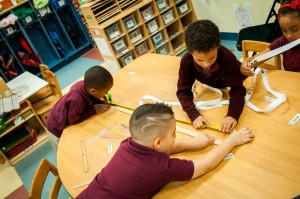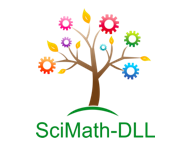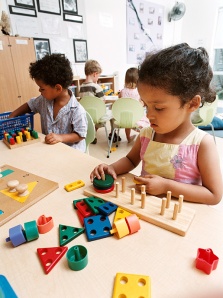Douglas H. Clements, preschool and kindergarten teacher, Kennedy Endowed Chair in Early Childhood Learning, Executive Director, Marsico Institute for Early Learning and Literacy, and one of the members of the Common Core work groups, responds (with assistance from Bill McCallum) on the issue of Math standards will be too challenging for young children.
Perhaps the most common criticism of the Common Core State Standards-Mathematics (CCSS-M) for young children is that they are not “developmentally appropriate” (e.g., Meisels, 2011). Unfortunately, the phrase “developmentally appropriate” too often functions as a Rorschach test for whatever a person wants to see or argue against.
Often, negative evaluations are based on an implicit acceptance of the view that all “fives” can and especially cannot do certain things. However, much of the mathematical thinking that some people say “cannot be done” until age 7 (or whatever) can be learned by children—most children—in high-quality environments. Further, children learn such thinking with understanding and joy—that’s developmentally appropriate.

Photo Credit: Casey R. Brown
Let’s consider some concrete examples. One concern is that 5-6-year-olds are not “ready” to learn place value. Perhaps the phrase itself—“place value”—raises the issue. Close inspection, however, reveals little reason for worry. First, note that research has identified at least seven developmental levels of learning place value, from very early concepts of grouping to understand the exponential nature of number systems in multiple bases (Clements & Sarama, 2014; Fuson, Smith, & Lo Cicero, 1997; Fuson, Wearne, et al., 1997; Rogers, 2012). Examination of the CCSS-M shows that kindergarten children only need to “Work with numbers 11–19 to gain foundations for place value” (p. 12, emphasis added) and first graders “Understand that the two digits of a two-digit number represent amounts of tens and ones” such as knowing that “The numbers 10, 20, 30, 40, 50, 60, 70, 80, 90 refer to one, two, three, four, five, six, seven, eight, or nine tens (and 0 ones).” Those are challenging but (for vast majority of children) achievable understandings (did you notice how many times the CCSS-M’s goals involve “understanding”)?
Personally, I have many concrete experiences with preschoolers who, given high-quality learning experiences, successfully tackle these ideas and more (Clements & Sarama, 2007, 2008). And love doing it. In Boston, a mother said she wasn’t sure her preschooler could understand mathematical ideas until he told her, “Eleven. That’s just ten and one, isn’t it?”
Talking about the “levels” of place value brings up a two important points. First, when educators use such levels—organized in a learning trajectory—to engage all children in meaningful mathematics at the right level for each—developmental appropriateness is ensured. Second, the Common Core was developed by first writing learning trajectories—at least the developmental progressions of levels of thinking. (Criticisms that the CCSS-M were “top-down,” starting with high school, e.g., Meisels, 2011, are simply incorrect.) Thus, learning trajectories are at the core of the Common Core.
Let’s take another example: arithmetic problems. Missing addend problems are a first grade standard. Some argue that tasks such as “fill in the blank: 3 + _ = 5” are cognitively out of range for children until, say, 2nd or 3rd grade. Some students may stumble if, unprepared, they are given such tasks in that form. However, most 4- to 5-year-olds in high-quality environments, when asked, “Give me 5 cubes. OK, now watch, I’m going to hide some! [Hides 2 in one hand, then shows the 3 in the other hand.] How many am I hiding?” will eagerly answer, “Two!” Format and interaction matter. So does working through research-based learning in counting and especially conceptual subitizing—quickly recognizing parts and wholes of small numbers (Clements, 1999).
The CCSS-M can help teachers with such work. Historically, most word problem types in U.S. textbooks have been simple one-step problem types. Other countries’ children are solving many types, including more complex two-step problems (Stigler, Fuson, Ham, & Kim, 1986). Further, given the opportunity, young U.S. children can solve a wide range of problems, even beyond the CCSS-M, such multiplication and division problems with remainders (Carpenter, Ansell, Franke, Fennema, & Weisbeck, 1993).

Photo credit: Casey R. Brown
One might still argue that the CCSS-M goals are inappropriate for some group of children. But this will be true of any set of standards that pose a worthwhile challenge to them. And our children deserve that challenge. Based on learning trajectories, teachers should always be working on the challenging-but-achievable levels for their class and for the individuals in it. But that does not mean we allow children starting at lower levels to stay behind others. That would relegate them to a trajectory of failure (see Vincent Costanza’s blog). Instead, we should work together to help them build up their mathematical foundations. And given this support, they do.
So, the concern of “developmental inappropriateness” is a misunderstanding. There are others.
- “The Common Core means that other domains, such as social-emotional development, will be de-emphasized.” The good news there is that high-quality implementations of mathematics curricula in preschools have shown not only increase in meaningful mathematics proficiencies, but also transfer to other domains, such as language and self-regulation (Clements, Sarama, Wolfe, & Spitler, 2013; Julie Sarama, Clements, Wolfe, & Spitler, 2012; Julie Sarama, Lange, Clements, & Wolfe, 2012). Further, preschool curricula can successfully combine social-emotional, literacy, language, science and mathematics (e.g., Julie Sarama, Brenneman, Clements, Duke, & Hemmeter, in press)—all the while enhancing, rather than competing with, play-based approaches (Farran, Aydogan, Kang, & Lipsey, 2005). Finally, those who say that “there should be time for both learning literacy, math, and science, and for play and games”—inadvertently show their limited knowledge of early math education by repeating one of the ubiquitous false dichotomies of early education. Two of the ways to guide learning in these subject-matter domains are through games and play.
- “The Common Core is a federal curriculum.” Wrong on both counts. First, it was created by the states—the National Governors Association and Council of Chief State School Officers—not the U.S. government. Second, the Common Core is a set of standards, not a curriculum (see Dorothy Strickland’s blog). It guides what goals to aim for but not how or what curriculum to teach.
- “Teachers voices were not heard.” Teachers were involved all the way. Many states, such as Arizona, convened meetings of teachers to review the standards at each of three cycles of review. Also, the CCSS-M were supported and validated by such organizations as the NEA, AFT, and NCTM, as well as early childhood organizations such as the NAEYC (see Jere Confrey’s post and this joint statement publicly expressing NAEYC’s and the NAECSS’s support for the Standards,and Clements, Sarama, & DiBiase, 2004, in which leaders of NAEYC contributed to a work that was used heavily in the CCSS-M).
- “The Common Core emphasizes rote skills taught by direct instruction.” First, the CCSS-M does not tell how to teach. But its descriptions of goals for children could not be further from this misconception. Consider the introduction to grade 2, which states (in concert with NCTM’s Curriculum Focal Points) that children “develop, discuss, and use efficient, accurate, and generalizable methods to compute sums and differences of whole numbers.” Second-graders develop and discuss strategies, then use them in problem solving.
- “There were no early childhood teachers or professionals involved.” As one of the contributors to the CCSS-M, I—a former preschool and kindergarten teacher who continuously works in preschools and primary-grade classrooms, with children and teachers—I can only hope these authors simply were sloppy in checking their facts.
Do we think everything is perfect? Of course not. Not even the content of the CCSS-M is (or ever will be) perfect. But only further implementation and study will give us an improved set of standards. Further, we wish that organizations would implement carefully and slowly, building up (from pre-K) and supporting all teachers and other educators in learning about, working on, and evaluating the CCSS-M. Schools that have done that report success, with teachers amazed by what their students can do (Kelleher, 2014). Appreciating what their children are learning means they not only stick with it, but they also improve every year (Clements, Sarama, Wolfe, & Spitler, 2014). We wish curriculum, and especially high-stakes assessments, would be carefully piloted with extensive research on outcomes, including unanticipated outcomes, before they are accepted and more widely disseminated (Julie Sarama & Clements, 2015) (or rejected and not used). We wish more educators would realize what’s truly developmentally inappropriate is present-day kindergarten curricula that “teach” children what they already know (Engel, Claessens, & Finch, 2013).
But we do think that too many find it easier to dramatically warn of all that could go wrong working with the Common Core (“Students will be pressured!” “There are not CC curricula yet!” “The kids will fail!”). Too few take the more difficult road of building positive solutions. Let’s stop biting the finger, and look where it’s pointing.
References
Carpenter, T. P., Ansell, E., Franke, M. L., Fennema, E. H., & Weisbeck, L. (1993). Models of problem solving: A study of kindergarten children’s problem-solving processes. Journal for Research in Mathematics Education, 24, 428-441.
Clements, D. H. (1999). Subitizing: What is it? Why teach it? Teaching Children Mathematics, 5, 400-405.
Clements, D. H., & Sarama, J. (2007). Effects of a preschool mathematics curriculum: Summative research on the Building Blocks project. Journal for Research in Mathematics Education, 38, 136-163.
Clements, D. H., & Sarama, J. (2008). Experimental evaluation of the effects of a research-based preschool mathematics curriculum. American Educational Research Journal, 45, 443-494.
Clements, D. H., & Sarama, J. (2014). Learning and teaching early math: The learning trajectories approach (2nd ed.). New York, NY: Routledge.
Clements, D. H., Sarama, J., & DiBiase, A.-M. (2004). Engaging young children in mathematics: Standards for early childhood mathematics education. Mahwah, NJ: Erlbaum.
Clements, D. H., Sarama, J., Wolfe, C. B., & Spitler, M. E. (2013). Longitudinal evaluation of a scale-up model for teaching mathematics with trajectories and technologies: Persistence of effects in the third year. American Educational Research Journal, 50(4), 812 – 850. doi: 10.3102/0002831212469270
Clements, D. H., Sarama, J., Wolfe, C. B., & Spitler, M. E. (2014). Sustainability of a scale-up intervention in early mathematics: Longitudinal evaluation of implementation fidelity. Early Education and Development, 26(3), 427-449. doi: 10.1080/10409289.2015.968242
Engel, M., Claessens, A., & Finch, M. A. (2013). Teaching students what they already know? The (mis)alignment between mathematics instructional content and student knowledge in kindergarten. Educational Evaluation and Policy Analysis, 35(2), 157–178. doi: 10.3102/0162373712461850
Farran, D. C., Aydogan, C., Kang, S. J., & Lipsey, M. (2005). Preschool classroom environments and the quantity and quality of children’s literacy and language behaviors. In D. Dickinson & S. Neuman (Eds.), Handbook of early literacy research (pp. 257-268). New York, NY: Guilford.
Fuson, K. C., Smith, S. T., & Lo Cicero, A. (1997). Supporting Latino first graders’ ten-structured thinking in urban classrooms. Journal for Research in Mathematics Education, 28, 738-760.
Fuson, K. C., Wearne, D., Hiebert, J. C., Murray, H. G., Human, P. G., Olivier, A. I., . . . Fennema, E. H. (1997). Children’s conceptual structures for multidigit numbers and methods of multidigit addition and subtraction. Journal for Research in Mathematics Education, 28, 130-162.
Kelleher, M. (2014). Common Core for Young Learners. Harvard Education Letter, 30 (4).
Meisels, S. J. (2011). Common Core standards pose dilemmas for early childhood. Retrieved from http://www.washingtonpost.com/blogs/answer-sheet/post/common-core-standards-pose-dilemmas-for-early-childhood/2011/11/28/gIQAPs1X6N_blog.html
Rogers, A. (2012). Steps in developing a quality whole number place value assessment for years 3-6: Unmasking the “experts”. Paper presented at the Mathetatics Education Research Group of Australasia, Singapore.
Sarama, J., Brenneman, K., Clements, D. H., Duke, N. K., & Hemmeter, M. L. (in press). Connect4Learning (C4L): The Preschool Curriculum. Lewisville, NC: Gryphon House.
Sarama, J., & Clements, D. H. (2015). Scaling up early mathematics interventions: Transitioning with trajectories and technologies. In B. Perry, A. MacDonald & A. Gervasoni (Eds.), Mathematics and transition to school (pp. 153-169). New York, NY: Springer.
Sarama, J., Clements, D. H., Wolfe, C. B., & Spitler, M. E. (2012). Longitudinal evaluation of a scale-up model for teaching mathematics with trajectories and technologies. Journal of Research on Educational Effectiveness, 5(2), 105-135.
Sarama, J., Lange, A., Clements, D. H., & Wolfe, C. B. (2012). The impacts of an early mathematics curriculum on emerging literacy and language. Early Childhood Research Quarterly, 27, 489-502. doi: 10.1016/j.ecresq.2011.12.002
Stigler, J. W., Fuson, K. C., Ham, M., & Kim, M. S. (1986). An analysis of addition and subtraction word problems in American and Soviet elementary mathematics textbooks. Cognition and Instruction, 3, 153-171.
Like this post? Share it!
 Less is known about why changing schools negatively affects children’s academic achievement, or how it affects children’s self-regulation. Of course, it may be that changing schools simply disrupts learning, particularly if children miss school or experience a discontinuity in curricula. However, the mechanism may be more complex. Building on developmental psychology theory and research that poverty-related risks are stressful, and that stress is associated with lower self-regulation, we tested the hypothesis that school mobility, one poverty-related risk, would compromise children’s self-regulation. And, based on prior research demonstrating a strong association between children’s self-regulation and math skills, we hypothesized that lower self-regulation would negatively affect children’s math skills. Here we define self-regulation as higher-order cognitive abilities that involve attention, inhibitory control, and planning. The current paper only focused on math achievement and did not measure reading achievement for several reasons. First, there is an abundance of prior research finding strong associations between children’s self-regulation and math achievement. Second, neuroscience research supports similar underlying brain regions involved self-regulation and solving math problems. And third, learning and doing math requires children to use complex, effortful, higher-order processes that also underlie self-regulation abilities.
Less is known about why changing schools negatively affects children’s academic achievement, or how it affects children’s self-regulation. Of course, it may be that changing schools simply disrupts learning, particularly if children miss school or experience a discontinuity in curricula. However, the mechanism may be more complex. Building on developmental psychology theory and research that poverty-related risks are stressful, and that stress is associated with lower self-regulation, we tested the hypothesis that school mobility, one poverty-related risk, would compromise children’s self-regulation. And, based on prior research demonstrating a strong association between children’s self-regulation and math skills, we hypothesized that lower self-regulation would negatively affect children’s math skills. Here we define self-regulation as higher-order cognitive abilities that involve attention, inhibitory control, and planning. The current paper only focused on math achievement and did not measure reading achievement for several reasons. First, there is an abundance of prior research finding strong associations between children’s self-regulation and math achievement. Second, neuroscience research supports similar underlying brain regions involved self-regulation and solving math problems. And third, learning and doing math requires children to use complex, effortful, higher-order processes that also underlie self-regulation abilities.


 Posted by NIEER
Posted by NIEER  re science, technology, engineering, and mathematics (STEM) into her classroom and how to engage DLLs in these activities. One day, she set out ramps and cars and let the kids play with them. Then she asked the children if they knew how they might make the cars go down the ramps more quickly? “Blocks!” said José, as he ran to the block center to get blocks to prop up his ramp. His classmate, Molly, looked shocked and said, ‘He talked!” This child’s teacher was amazed at how rich (although relatively simple) STEM materials provided the fodder needed to encourage José to express himself out loud.
re science, technology, engineering, and mathematics (STEM) into her classroom and how to engage DLLs in these activities. One day, she set out ramps and cars and let the kids play with them. Then she asked the children if they knew how they might make the cars go down the ramps more quickly? “Blocks!” said José, as he ran to the block center to get blocks to prop up his ramp. His classmate, Molly, looked shocked and said, ‘He talked!” This child’s teacher was amazed at how rich (although relatively simple) STEM materials provided the fodder needed to encourage José to express himself out loud.

















